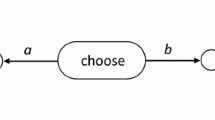Abstract
We show that Bell inequalities can be violated in the macroscopic world. The macroworld violation is illustrated using an example involving connected vessels of water. We show that whether the violation of inequalities occurs in the microworld or the macroworld, it is the identification of nonidentical events that plays a crucial role. Specifically, we prove that if nonidentical events are consistently differentiated, Bell-type Pitowsky inequalities are no longer violated, even for Bohm's example of two entangled spin 1/2 quantum particles. We show how Bell inequalities can be violated in cognition, specifically in the relationship between abstract concepts and specific instances of these concepts. This supports the hypothesis that genuine quantum structure exists in the mind. We introduce a model where the amount of nonlocality and the degree of quantum uncertainty are parameterized, and demonstrate that increasing nonlocality increases the degree of violation, while increasing quantum uncertainty decreases the degree of violation.
Similar content being viewed by others
REFERENCES
A. Aspect, P. Grangier, and G. Roger, “Experimental tests of realistic local theories via Bell's theorem,” Phys. Rev. Lett. 47, 460 (1981).
A. Aspect, P. Grangier, and G. Roger, “Experimental realization of Einstein-sPodolsky-Rosen-Bohm gedankenexperiment: A new violation of Bell's inequalities,” Phys. Rev. Lett. 48, 91 (1982).
D. Aerts, “The one and the many,” Doctoral dissertation (Brussels Free University, 1981).
D. Aerts, “Example of a macroscopical situation that violates Bell inequalities,” Lett. Nuovo Cim. 34, 107 (1982).
D. Aerts, “The missing elements of reality in the description of quantum mechanics of the EPR paradox situation,” Helv. Phys. Acta. 57, 421 (1984).
D. Aerts, “The physical origin of the EPR paradox and how to violate Bell inequalities by macroscopical systems,” in On the Foundations of modern Physics, P. Lathi and P. Mittelstaedt, eds. (World Scientific, Singapore, 305, 1985a).
D. Aerts, “A possible explanation for the probabilities of quantum mechanics and a macro-scopical situation that violates Bell inequalities,” in Recent Developments in Quantum Logic, P. Mittelstaedt et al., eds. (Bibliographisches Institut, Mannheim, 235, 1985b).
D. Aerts, “A mechanistic classical laboratory situation violating the Bell inequalities with 2/2, exactly ‘in the same way’ as its violations by the EPR experiments,” Helv. Phys. Acta 64, 1–24 (1991).
D. Aerts, “The construction of reality and its influence on the understanding of quantum structures,” Int. J. Theor. Phys. 31, 1815–1837 (1992).
D. Aerts, “The description of joint quantum entities and the formulation of a paradox,” Int. J. Theor. Phys. 39, 483 (2000).
D. Aerts, S. Aerts, B. Coecke, and F. Valckenborgh, “The meaning of the violation of Bell Inequalities: nonlocal correlation or quantum behavior?,” preprint (Free University of Brussels, 1995).
D. Aerts and T. Durt, “Quantum, classical and intermediate, an illustrative example,” Found. Phys. 24, 1353–1368 (1994).
D. Aerts and L. Gabora, “Quantum mind web course, lecture week 10,” part of “Conscious-ness at the Millennium: Quantum Approaches to Understanding the Mind,” an online course offered by consciousness studies (The University of Arizona, September 27, 1999 through January 14, 2000).
D. Aerts and L. Szabo, “Is quantum mechanics really a non-Kolmogorovian probability theory,” preprint, CLEA (Brussels Free University, 1993).
J. S. Bell, “On the Einstein_Podolsky–Rosen paradox,” Physics 1, 195 (1964).
D. Bohm, Quantum Theory (Prentice–Hall, Englewood Cliffs, New York, 1951).
J. F. Clauser, Phys. Rev. Lett. 36, 1223 (1976).
J. F. Clauser and M. A. Horne, Phys. Rev. D 10, 526 (1976).
A. Einstein, B. Podolskyi, and N. Rosen, “Can quantum mechanical description of physical reality be considered complete,” Phys. Rev. 47, 777 (1935). Faraci et al., Lett. Nuovo Cim. 9, 607 (1974).
S. J. Freedman and J. F. Clauser, Phys. Rev. Lett. 28, 938 (1972).
L. Gabora, “Autocatalytic closure in a cognitive system: A tentative scenario for the origin of culture,” Psycoloquy 9, (67), (1998).
L. Gabora, “Weaving, bending, patching, mending the fabric of reality: A cognitive science perspective on worldview inconsistency,” Foundations of Science 3(2), 395–428 (1999).
L. Gabora, “Conceptual closure: Weaving memories into an interconnected worldview,” in Closure: Emergent Organizations and their Dynamics, G. Van de Vijver and J. Chandler, eds., Ann. New York Acad. Sci. (2000).
P. J. B. Hancock, L. S. Smith, and W. A. Phillips, “A biologically supported error-correcting learning rule,” Neural Computation 3(2), 201–212 (1991).
S. B. Holden and M. Niranjan, “Average-case learning curves for radial basis function networks,” Neural Computation 9(2), 441–460 (1997).
R. A. Holt and F. M. Pipkin, preprint Harvard University (1973).
S. A. Kauffman, Origins of Order (Oxford University Press, Oxford, 1993).
Kasday, Ullmann and Wu, Bull. Am. Phys. Soc. 15, 586 (1970).
Y. W. Lu, N. Sundararajan, and P. Saratchandran, “A sequential learning scheme for function approximation using minimal radial basis function neural networks,” Neural Computation 9(2), 461–478 (1997).
I. Pitowsky, Quantum Probability-Quantum Logic (Springer, Berlin, New York, 1989).
D. Willshaw and P. Dayan, “Optimal plasticity from matrix memories: What goes up must come down,” Neural Computation 2(1), 85–93 (1990).
Author information
Authors and Affiliations
Rights and permissions
About this article
Cite this article
Aerts, D., Aerts, S., Broekaert, J. et al. The Violation of Bell Inequalities in the Macroworld. Foundations of Physics 30, 1387–1414 (2000). https://doi.org/10.1023/A:1026449716544
Issue Date:
DOI: https://doi.org/10.1023/A:1026449716544



